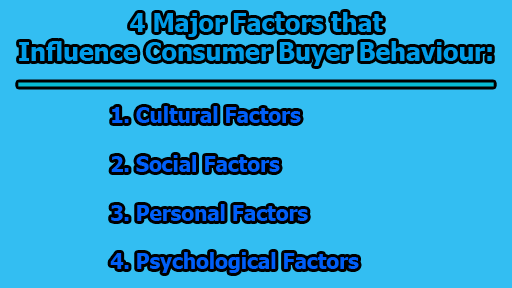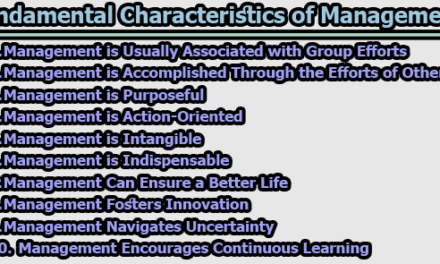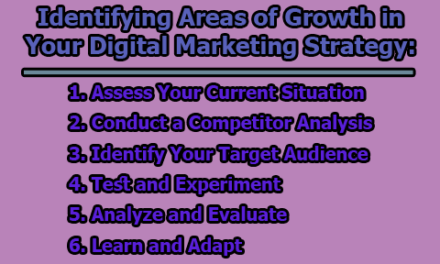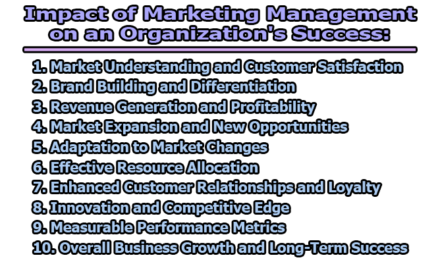4 Major Factors that Influence Consumer Buyer Behaviour:
Consumer buyer behavior is a complex and dynamic process influenced by a multitude of factors. Understanding these factors is paramount for businesses and marketers seeking to effectively engage their target audience and drive sales. Four major factors that play a pivotal role in shaping consumer buyer behavior are cultural, social, personal, and psychological influences. Each of these factors holds a distinct set of elements that guide and mold how consumers make their purchasing decisions. In this article, we will delve into 4 major factors that influence consumer buyer behaviour.
1. Cultural Factors:
Cultural factors encompass the broader societal and cultural context within which individuals are raised and live. These factors have a profound impact on consumer behavior as they shape a person’s values, beliefs, customs, and norms. Understanding how culture affects consumer decisions is crucial for marketers when creating products, services, and marketing campaigns. Here are some key aspects of cultural factors:
1.1 Culture: Culture is a fundamental determinant of consumer behavior. It refers to the shared values, customs, traditions, and beliefs of a specific group of people. Culture can be divided into national culture, regional culture, and even organizational culture, each of which has unique characteristics. Here are some ways culture influences consumer behavior:
- Language: Language is a crucial aspect of culture. Different languages can lead to variations in how people perceive and respond to marketing messages. Multinational companies often need to translate their advertising to align with the cultural nuances of different regions.
- Symbols and Signs: Cultural symbols and signs can hold deep meaning for a society. For example, certain colors, gestures, or images may be considered sacred, offensive, or auspicious in specific cultures. Using or avoiding these symbols in marketing can impact a product’s success.
- Taboos and Norms: Different cultures have different taboos and norms regarding what is acceptable behavior and what is not. For example, dietary restrictions based on religious beliefs can significantly influence food and beverage consumption.
- Festivals and Celebrations: Cultural festivals and celebrations often lead to increased consumption. For instance, gift-giving is a common practice during holidays, leading to changes in consumer buying patterns.
1.2 Subculture: Within a larger culture, there exist subcultures that share specific values, beliefs, and practices. These subcultures can be based on factors such as ethnicity, religion, age, gender, or even hobbies. Understanding and targeting subcultures can be a strategic advantage for businesses.
- Example: Consider the influence of subcultures on dietary choices. Vegetarianism or veganism, for instance, is often associated with subcultures that share environmental, ethical, or health-related values. Companies may develop specific products and marketing strategies tailored to these subcultures.
1.3 Social Class: Social class is another critical component of cultural factors. It refers to the position or rank an individual or family holds in society based on factors like income, education, and occupation. Different social classes have distinct consumption patterns and preferences.
- Example: Luxury brands target consumers in higher social classes, offering exclusive and high-priced products. In contrast, brands catering to lower social classes may focus on affordability and functionality.
Cultural factors can be dynamic and evolve over time, influenced by globalization, changing demographics, and shifts in societal values. For marketers, adapting to cultural nuances and understanding the cultural diversity of their target markets is essential for effective consumer engagement. Failing to consider cultural factors can lead to misunderstandings, misinterpretations, and potentially unsuccessful marketing efforts.
2. Social Factors:
Social factors encompass the impact of various social groups and interpersonal interactions on an individual’s purchasing decisions. These factors highlight the importance of a person’s connections and relationships with others in influencing their buying behavior. Here are some key aspects of social factors:
2.1 Reference Groups: Reference groups are groups of people to whom an individual looks for guidance, advice, and approval when making purchasing decisions. These groups can be formal or informal and play a significant role in shaping consumer choices.
- Primary Reference Groups: These are typically close-knit, intimate groups like family, friends, and close colleagues. Their opinions and recommendations often have a profound impact on personal buying decisions. For instance, a person might choose a particular smartphone brand because their close friends use the same brand.
- Secondary Reference Groups: These are larger, more formal groups, such as professional associations, social clubs, or online communities. People might turn to these groups for recommendations or information related to specific interests or activities, like fitness or travel.
- Aspirational Reference Groups: These are groups that individuals aspire to join or emulate. Celebrities and influencers often fall into this category. Their endorsement of a product can significantly influence consumers’ purchase decisions.
2.2 Family: The family is one of the most significant social units affecting consumer behavior. The family plays a crucial role in the socialization process, influencing values, beliefs, and consumption patterns. Family members can hold different roles in the decision-making process:
- Initiator: The person who first suggests or identifies a need for a particular product or service. For example, a child might initiate the desire for a family vacation.
- Influencer: Family members who impact the decision by providing information, advice, or opinions. Parents often serve as influencers for their children’s purchases.
- Decider: The individual who ultimately makes the buying decision. This might be the person with the most authority or financial control in the family.
- Purchaser: The person who physically buys the product or service.
- User: The individual who consumes or uses the product. This can be different from the purchaser, especially in the case of products for children or the household.
2.3 Social Roles and Status: An individual’s social role within a group or society, as well as their social status, can have a significant impact on their buying decisions. Social roles are sets of behaviors and expectations associated with a particular position in society, while social status refers to one’s position in relation to others in society.
- Example: A person’s role as a parent may influence their purchase of products such as diapers, baby food, and toys. A person’s social status, such as being a high-ranking executive in a company, may influence the choice of luxury cars or high-end clothing.
Understanding social factors is crucial for businesses and marketers, as they can tailor their marketing strategies to leverage the influence of reference groups, family dynamics, and social roles to connect with their target audience effectively. Recognizing the power of these social factors can lead to more successful and targeted marketing campaigns.
3. Personal Factors:
Personal factors refer to the unique characteristics and individual attributes of consumers that shape their purchasing decisions. These factors vary from person to person and include elements such as age, occupation, lifestyle, and personality. Understanding personal factors helps marketers segment their target audience effectively and tailor their strategies accordingly. Here are some key aspects of personal factors:
3.1 Age and Life Stage: A person’s age and the life stage they are in can significantly impact their consumption patterns. Different age groups have distinct needs, preferences, and priorities:
- Children and Teens: Younger individuals often seek products that cater to their desires and interests, such as toys, video games, and trendy fashion.
- Young Adults: This group may focus on items related to establishing independence, like cars, housing, and personal technology.
- Middle-Aged Adults: This demographic may prioritize products related to family and home life, including furniture, appliances, and family-oriented services.
- Seniors: Older consumers may concentrate on products and services that enhance their quality of life and well-being, such as healthcare and leisure activities.
3.2 Occupation: An individual’s occupation or profession can have a significant impact on their purchasing decisions. Different jobs may require specific attire, tools, or equipment, influencing what products they need:
- Example: A doctor may need specialized medical equipment, while a construction worker may require safety gear and tools. Marketers can target these occupational needs with tailored product offerings.
3.3 Lifestyle and Personality: A person’s lifestyle choices and personality traits play a crucial role in determining their buying behavior. Lifestyle encompasses the activities, interests, and opinions that define a person’s way of living. Personality traits can include characteristics like adventurousness, conscientiousness, and openness to new experiences:
- Lifestyle: Marketers often segment their target audience based on lifestyle preferences. For example, outdoor enthusiasts may be interested in camping gear and hiking equipment, while those with a focus on health and fitness might be more receptive to fitness products and organic foods.
- Personality: Consumers with certain personality traits may be drawn to specific products that align with their self-image. For example, individuals who value environmental sustainability may choose eco-friendly products and support companies with green initiatives.
3.4 Values and Beliefs: An individual’s values and beliefs significantly influence their consumer choices. These values can be related to ethical, environmental, or cultural considerations. Understanding and aligning with consumers’ values can be a powerful marketing strategy:
- Example: Brands that emphasize social responsibility and sustainability in their products and operations can attract consumers who share those values. Such consumers may be more willing to support companies with similar beliefs.
Personal factors are essential for marketers to consider when creating products, designing marketing campaigns, and tailoring messaging. Recognizing the uniqueness of each consumer and acknowledging the personal factors that shape their choices allows businesses to connect on a more individualized and relatable level.
4. Psychological Factors:
Psychological factors refer to the individual cognitive and emotional aspects that influence consumer behavior. These factors include perception, motivation, attitudes, and learning, among others. Understanding how these psychological factors work can help businesses create more effective marketing strategies and better connect with their target audience. Here are some key aspects of psychological factors:
4.1 Perception: Perception is the process by which individuals select, organize, and interpret sensory information from their surroundings. It affects how consumers perceive products, brands, and marketing messages. Key elements of perception in consumer behavior include:
- Sensory Perception: Consumers use their five senses (sight, sound, touch, taste, and smell) to evaluate products. Packaging design, product appearance, and sensory experiences all impact how a product is perceived.
- Selective Attention: People tend to focus on certain stimuli while filtering out others. Marketers need to grab the consumer’s attention and make their product or message stand out.
- Perceptual Organization: Consumers organize and categorize information to make sense of their environment. Marketers use this concept to create associations between their products and positive attributes.
- Interpretation: How consumers interpret information depends on their personal experiences and background. This interpretation can vary widely from one individual to another.
4.2 Motivation: Motivation is the internal state or driving force that directs individuals towards satisfying specific needs and desires. Understanding consumer motivation is vital for businesses, as it helps in shaping marketing strategies and product positioning. Key motivational factors include:
- Maslow’s Hierarchy of Needs: Abraham Maslow’s theory of human motivation suggests that people are driven by a hierarchy of needs, starting with basic physiological needs (e.g., food and shelter) and progressing to higher-level needs like self-esteem and self-actualization. Marketers can appeal to these needs to influence consumer behavior.
- Incentives and Rewards: Consumers are often motivated by incentives, such as discounts, promotions, and rewards programs. Marketers can use these incentives to encourage certain behaviors, such as making a purchase or referring a friend.
4.3 Attitude: An individual’s attitude represents their overall evaluation or feelings about a product, brand, or topic. Attitudes are formed based on beliefs, emotions, and past experiences. Marketers aim to influence and shape consumer attitudes through advertising, branding, and customer experiences.
- Attitude Change: Marketers often try to change or reinforce consumer attitudes through various persuasive techniques. This may involve highlighting a product’s benefits, addressing concerns, or appealing to emotions.
4.4 Learning and Memory: Learning involves the process of acquiring information and knowledge, while memory is the ability to retain and recall that information. Learning and memory play a role in consumer decision-making by influencing how consumers recognize, evaluate, and remember products and brands.
- Classical Conditioning: Brands often use classical conditioning by associating their products with positive stimuli or experiences. Over time, this association can create a positive response to the brand.
- Operant Conditioning: Marketers also use operant conditioning by offering rewards or punishments for specific behaviors. For example, loyalty programs that reward customers for repeat purchases encourage brand loyalty.
Understanding these psychological factors allows marketers to create strategies that not only attract consumers but also influence their decision-making processes. Businesses can use these insights to build brand loyalty, shape consumer perceptions, and encourage desired behaviors.
In conclusion, consumer buyer behavior is a multifaceted phenomenon that emerges from the interplay of cultural, social, personal, and psychological factors. Recognizing the profound influence of these factors on consumers’ choices is fundamental for businesses and marketers as they develop products, design marketing campaigns, and seek to establish lasting connections with their target audience.

Former Student at Rajshahi University










